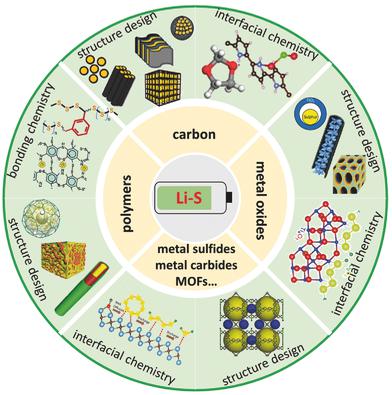当前位置:
X-MOL 学术
›
Small Methods
›
论文详情
Our official English website, www.x-mol.net, welcomes your feedback! (Note: you will need to create a separate account there.)
Nanostructured Host Materials for Trapping Sulfur in Rechargeable Li–S Batteries: Structure Design and Interfacial Chemistry
Small Methods ( IF 12.4 ) Pub Date : 2017-11-27 , DOI: 10.1002/smtd.201700279 Jun Zhang 1, 2 , Hui Huang 2 , Jiwoong Bae 1 , Sheng‐Heng Chung 1 , Wenkui Zhang 2 , Arumugam Manthiram 1 , Guihua Yu 1
Small Methods ( IF 12.4 ) Pub Date : 2017-11-27 , DOI: 10.1002/smtd.201700279 Jun Zhang 1, 2 , Hui Huang 2 , Jiwoong Bae 1 , Sheng‐Heng Chung 1 , Wenkui Zhang 2 , Arumugam Manthiram 1 , Guihua Yu 1
Affiliation

|
Lithium–sulfur (Li–S) batteries are considered as a promising candidate for next‐generation energy‐storage devices due to their high energy density, low cost, and ecofriendliness. However, the practical application of Li–S batteries faces challenges arising from the cathode, the electrolyte, and the anode, including the intrinsically low conductivity of sulfur and lithium sulfide (Li2S), the high solubility of polysulfides in the electrolytes commonly used, and the dendrite growth of metallic lithium anodes. In recent years, much effort has been made to improve the performance of Li–S batteries by modifying the cathode, host material, binder, electrolyte, membrane, anode, and cell configuration. Here, the focus is on the cathode aspect, and the design and surface modification of nanostructured host materials for sulfur and Li2S are investigated in detail.
中文翻译:

纳米结构主体材料,用于在可充电Li–S电池中捕集硫:结构设计和界面化学
锂硫(Li–S)电池具有高能量密度,低成本和环保的特点,因此被认为是下一代储能设备的有前途的候选者。但是,Li-S电池的实际应用面临着来自阴极,电解质和阳极的挑战,包括硫和硫化锂的固有低电导率(Li 2S),多硫化物在常用电解质中的高溶解度以及金属锂阳极的枝晶生长。近年来,人们通过修改阴极,主体材料,粘合剂,电解质,膜,阳极和电池的配置,为提高Li-S电池的性能做出了巨大的努力。在此,重点放在阴极方面,并详细研究了用于硫和Li 2 S的纳米结构主体材料的设计和表面改性。
更新日期:2017-11-27
中文翻译:

纳米结构主体材料,用于在可充电Li–S电池中捕集硫:结构设计和界面化学
锂硫(Li–S)电池具有高能量密度,低成本和环保的特点,因此被认为是下一代储能设备的有前途的候选者。但是,Li-S电池的实际应用面临着来自阴极,电解质和阳极的挑战,包括硫和硫化锂的固有低电导率(Li 2S),多硫化物在常用电解质中的高溶解度以及金属锂阳极的枝晶生长。近年来,人们通过修改阴极,主体材料,粘合剂,电解质,膜,阳极和电池的配置,为提高Li-S电池的性能做出了巨大的努力。在此,重点放在阴极方面,并详细研究了用于硫和Li 2 S的纳米结构主体材料的设计和表面改性。


























 京公网安备 11010802027423号
京公网安备 11010802027423号